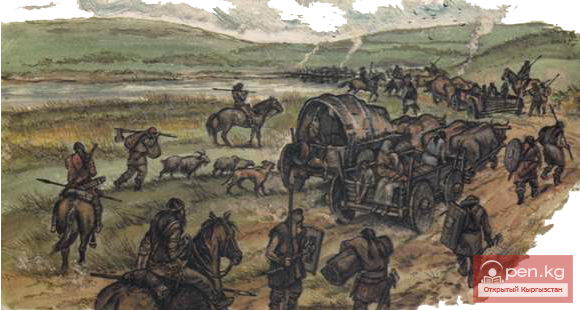
The analysis shows the continuity of historical and genealogical information in the sanjyra. A stable genealogical trace is represented by the legend of Dolon-biy and his descendants. In various versions of the sanjyra, he appears as the primordial ancestor of the Kyrgyz of the right ("on kanat") and left wings ("sol kanat").
In different versions, he is the progenitor of all major branches ("on kanat", "sol kanat", "ichkilik") of the ethnopolitical structure of the Kyrgyz.
The ideological trace of the sanjyra is evident in the formation of a hierarchical clan structure at the levels of "bir atanyn baldary" ("children of one father"), "uruuk", and "uroo". As the sanjyra shows, at the level of "uruu", the tribe was a universal category, formed not only on the basis of blood relations. The "uruu" comprised groups of different origins, united by genealogical-territorial principles—under a single ideology, without which there would have been no socio-economic, territorial-demographic expansion and political rise of this union. The foreign groups or ethnic components that became part of the tribe could integrate into its genealogy. There are many examples where whole tribes were formed from the descendants of adopted children, i.e., "tonduu uul", who had foreign origins by blood relations. Such groups, according to clan laws, were considered full-fledged members of the society in which they were integrated, and adopted children were equated with their own children, which corresponded to genealogical norms. This characteristic allowed the tribe to gather diverse groups around itself and occupy vast territories. The genealogy of the Tagai clan, one of the major branches of the right wing, attests to this. According to genealogical traditions, the tribes "sayak", "azyq", and "cherik" were adopted by the legendary ancestor of the right wing, Tagai-biy.
There were cases when a small group representing a certain clan, due to various circumstances, found itself in another union, where it was perceived as outsiders or slaves. The genealogical line of such groups was severed from the original branch, and they gradually merged with the new tribe. As genealogical data indicate, they were given new names, which were permanently attached to them, reminding of their foreign origins. Incorporated foreign groups were effectively severed from the tribe they had previously belonged to and continued their lineage as part of the new tribe. They were already considered subdivisions of the new clan community.
Kinship closeness in the sanjyra was determined by genealogical principles. Within the clan, the genealogy itself had ideological significance.
Based on its data, one could clearly trace the genealogical chain of ancestors preserved in the collective memory. Several patriarchal families united by blood relations were called "bir atanyn baldary", i.e., "children of one father" - they were considered descendants of one person who was their ancestor in the fourth or fifth generation.
The relationships among members of society largely depended on genealogical criteria based on knowledge of lineage. Among nomads, knowledge of seven ancestors was particularly revered, legally formalizing a person's belonging to a particular clan or lineage: "Kim jeti atasyn bilbese, el bez eri" (He who does not know his seven ancestors is considered a renegade) - states the moral code.
In the family circle, reverence for the seven ancestors became a spiritual relic and was denoted by terms such as "ata", "chon ata", "baba", "buba", "kubaar", "zhoto", "zhete". The people's memory preserved sayings and expressions that confirm the deep tradition of this custom. For example, "Zhetege zhetchuu kek" - revenge to the seventh generation, "Kudai kylsa kubaaryn-dyn akysy barby" - if God has determined it, does your kubaar have the right, "Kubaaryn-dyn kuu chokusu", literally - "may the devil take the dried tops of your ancestors", etc.
Genealogical ties were maintained specifically in "uruuk" or within the clan circle. This was facilitated by norms of marital and kinship relations that had been developed over centuries and were strictly adhered to by all members of the community. "Al kezde jeti atasyn surap kyz bermek rasim bolgon" (In the past, it was customary to ask about the seven ancestors before giving a girl in marriage), - states the sanjyra. This meant that marriage within the clan was prohibited until seven generations had passed. It was believed that this prohibition prevented undesirable consequences of close kin marriages.
At the same time, the sanjyra did not conceal the social origins of certain foreign groups that became part of the tribe, including as slaves. Although such groups had long adapted within the tribe, their names, which reminded of such origins, remained unchanged. In principle, this did not mean that they had to occupy a low social position. In nomadic society, there was no strong displacement of groups based on this criterion; on the contrary, the number increased due to the inclusion of new members, and therefore the strength of the clan and tribe increased. The sanjyra merely recorded and reminded of their origins.
Sanjyra - the chronicle of Kyrgyz tribes












































